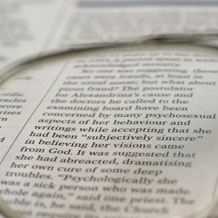 What it is:
What it is:
As we age, our eyes lose their ability to focus. This is called presbyopia. It affects everyone after age 40.
What You Need To Do:
If you are having trouble reading fine print, schedule an eye exam.
Why It’s Important:
Your ophthalmologist (Eye M.D.) can give you a prescription for reading glasses. Proper glasses can prevent tired eyes and headaches.
Symptoms
You may start to notice presbyopia around the age of 40, when you begin to hold reading materials farther away from your face in order to see them more clearly. This familiar event is often the first sign of presbyopia, which, if left uncorrected, can cause eye fatigue and headaches.
It is not a disorder or disease, but rather a natural aging process of the eye. Presbyopia literally means “old eye” in Greek.
Treatment
Presbyopia is treated with corrective lenses. Depending on your vision, several options are available.
If you do not already wear lenses for conditions such as nearsightedness, farsightedness or astigmatism, you may only have to wear eyeglasses when reading or performing close tasks. Prescription eyeglasses help refract, or bend, light rays before they enter the eye to compensate for the loss of near vision.
If you already wear eyeglasses, you may need bifocals or trifocals to correct for presbyopia. Bifocals provide correction for both near and far vision. Trifocals provide correction for near, intermediate and far vision. Progressive lenses offer the same corrections as bifocals or trifocals. But unlike bifocals or trifocals, which have a distinct line between levels of correction, progressive lenses are made with a gradual change in correction levels from the top of the lenses to the bottom.
If you prefer to wear contacts rather than eyeglasses, there are two types of contact lenses available. Monovision contacts correct one eye for distance vision and the other eye for close up vision. Bifocal and trifocal contact lenses correct for near vision in the bottom portion of the contact lens while the middle and/or top portion corrects for other refractive errors.
Tests/Diagnosis
A basic eye exam can diagnose presbyopia. This will include a test for visual acuity using an eye chart and measurements to determine a prescription for glasses or contact lenses.
Your eye care professional will conduct an eye exam with the help of an instrument called a phoropter. This contains a number of lenses of varying power.
By having an individual look at an eye chart through these lenses, the optometrist or ophthalmologist can estimate the amount of refractive error. A retinoscope is also used to shine a light into the patient’s eye and view the reflection from the retina in the back of the eye.
Causes/Risk Factors
Presbyopia is a normal part of aging.
When you are young, the lens in your eye is soft and flexible. The lens can change its shape easily, allowing you to focus on objects both near and far away.
After age 40, the lens becomes more rigid and cannot change shape as easily as it once did. As a result, it is more difficult for the eye to focus clearly on close objects. Reading and performing other close-up tasks such as threading a needle can become very difficult.
(Information Provided by EyeCareAmerica)

